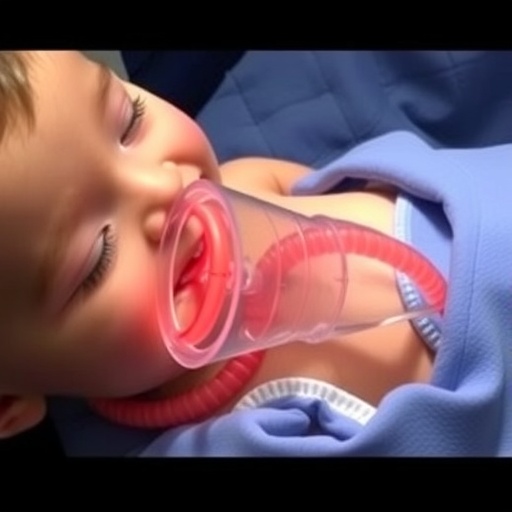In a recent study published in Pediatr Radiol, Kambhampati, Mehta, and Sah delve into the specific medical intricacies surrounding gastrojejunostomy tube replacement among pediatric patients. Their research is both timely and vital, particularly as the need for gastroenteric feeding solutions rises in clinical pediatrics. Their findings not only shed light on the frequency of tube replacements but also investigate the corresponding outcomes, setting the stage for enhanced understanding in the management of such procedures.
In the realm of pediatric medicine, gastrojejunostomy tubes are invaluable tools. They permit nutritional support for children who are unable to consume food orally due to various health challenges. Such tube placements are routinely performed under carefully controlled medical conditions, guided by both the child’s physical health and nutritional needs. However, as with any medical device, the maintenance and replacement of these tubes pose significant challenges. This study seeks to rectify any gaps in knowledge regarding the frequency of necessary replacements as well as the outcomes associated with them.
The scope of the research spans a single-center experience, and the authors aim to provide an in-depth review that may illuminate best practices in gastrojejunostomy tube management. Notably, Kambhampati, Mehta, and Sah emphasize that the procedures and outcomes they reviewed can serve as a benchmark for other pediatric units. This empirical foundation allows for comparisons with broader datasets and might pave the way for improved protocols in tube management.
.adsslot_Mvnm17J2N3{width:728px !important;height:90px !important;}
@media(max-width:1199px){ .adsslot_Mvnm17J2N3{width:468px !important;height:60px !important;}
}
@media(max-width:767px){ .adsslot_Mvnm17J2N3{width:320px !important;height:50px !important;}
}
ADVERTISEMENT
From a methodological standpoint, the authors adopted a retrospective study design which analyzed data from medical records. Such a detailed approach afforded the researchers the opportunity to derive substantial statistical insights into the frequency of tube replacements. The results revealed that children requiring gastrojejunostomy were prone to multiple replacement procedures, underscoring an essential aspect of post-operative care that often lacks sufficient coverage in paediatric literature.
The authors also evaluated the outcomes linked to the replacement of gastrojejunostomy tubes and how they may vary depending on the age and underlying medical conditions of the patients. Their observations revealed significant variance based on demographic and health factors, reiterating the necessity for a tailored approach in pediatric gastroenterology. Each replacement event is perhaps seen as not just a technical procedure, but a critical moment that intersects with the child’s overall treatment trajectory.
Moreover, the authors highlight the complications associated with tube replacements. While most procedures yield favorable outcomes, some patients encounter infections, tube dislodgments, and other complications that require intervention. The study further discusses potential strategies for mitigating these risks, advocating for a comprehensive care model that includes parental education and continuous monitoring post-replacement.
In their discourse, Kambhampati and colleagues also address the psychological dimensions involved in pediatric care. Children undergoing frequent gastrojejunostomy tube replacements can experience anxiety and distress. The authors point out that healthcare providers have a compelling duty to recognize and address these emotional aspects, ensuring that the child’s psychological well-being is prioritized alongside their physical health.
The conversation extends into the technological advancements in gastroenterology that may augment the management of gastrojejunostomy tubes. Innovations in materials and tube design hold promise for reducing replacement frequencies and improving overall patient satisfaction. The potential for smart technology – such as sensors that alert caregivers to complications – is also identified as a future consideration in this field.
As the study draws to a close, the researchers reiterate a theme prevalent throughout their findings: the necessity of clarity in communication between health professionals and families. The importance of ongoing education about gastrojejunostomy tube care is emphasized, advocating for enhanced collaborative efforts among healthcare teams to disseminate critical information to patients and caregivers.
Kambhampati, Mehta, and Sah’s research on gastrojejunostomy tube replacement in children marks a significant contribution to pediatric literature. Their thorough examination illuminates the complexities surrounding the management of such tubes and underscores the vital nature of ongoing research in this field. While their study reflects a singular clinical experience, its implications are far-reaching, encouraging interdisciplinary dialogue and informed practices across the pediatric community.
In summary, the frequency and outcomes related to gastrojejunostomy tube replacements reveal extensive avenues for improvement within pediatric healthcare. Continued focus on this niche area, motivated by both empirical research and compassionate care, is essential. The authors’ call to action for improvements and increased awareness serves as a meaningful guide for clinicians navigating the complexities of pediatric feeding solutions.
Subject of Research: Gastrojejunostomy tube replacement in children
Article Title: Frequency and outcomes of gastrojejunostomy tube replacement in children – a single-centre experience: reply to Yatham et al.
Article References: Kambhampati, B., Mehta, R. & Sah, R. Frequency and outcomes of gastrojejunostomy tube replacement in children – a single-centre experience: reply to Yatham et al. Pediatr Radiol (2025). https://doi.org/10.1007/s00247-025-06355-7
Image Credits: AI Generated
DOI: https://doi.org/10.1007/s00247-025-06355-7
Keywords: Gastrojejunostomy, pediatric medicine, tube replacement, outcomes, healthcare, technology, emotional well-being.
Tags: best practices for gastrojejunostomy tube carechallenges of tube maintenance in childrenclinical pediatrics gastrojejunostomy tubesenhancing pediatric gastroenteric feedingfrequency of tube replacements in pediatric patientsmedical intricacies of tube replacementnutritional support in pediatricsoutcomes of gastrojejunostomy tube managementpediatric feeding solutionspediatric gastrojejunostomy tube replacementsingle-center pediatric gastrojejunostomy studystudy on pediatric tube replacement outcomes





